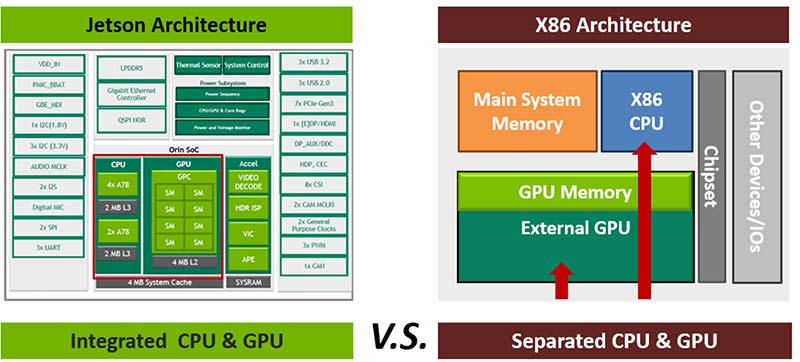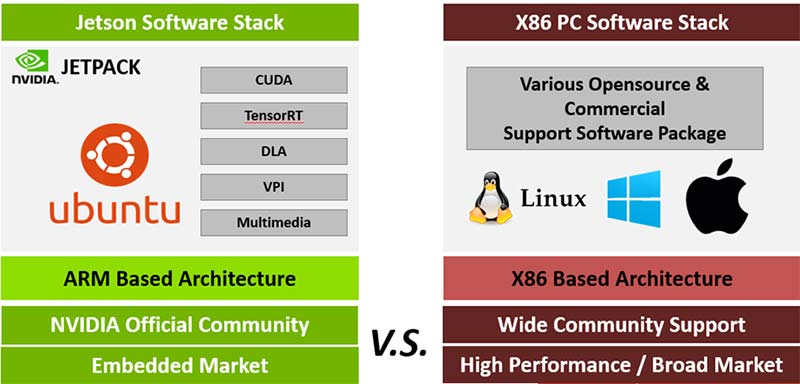HOME / Technologies / x86 vs Jetson: Architecture and Software for Advanced Computing
x86 vs Jetson: Architecture and Software for Advanced Computing
As technology advances, the need for more efficient and specialized computing platforms has become evident. Two popular architectures in the world of embedded systems and AI development are NVIDIA Jetson and x86 systems. While both have their unique strengths, the NVIDIA Jetson platform is increasingly gaining attention for specific applications. In this article, we will explore the fundamental differences between these two systems from both hardware and software perspectives.

Hardware Differences:
- CPU & GPU Design: The NVIDIA Jetson platform integrates an ARM-based CPU and GPU within a single SoC (System on Chip), while in an x86 system, the CPU typically operates independently, and if enhanced AI performance is required, an additional discrete GPU is usually added via PEG or PCIe slots. This difference in design philosophy between a singular integrated SoC (Jetson) and a modular approach (x86) leads to variations in performance, efficiency, and versatility. Jetson's all-in-one approach allows for more streamlined communication between components, which can result in lower latency and reduced power consumption.

- Memory Design: Memory handling also sets these two systems apart. In Jetson systems, the CPU and GPU share the same memory pool, reducing latency and enhancing power efficiency. In contrast, x86 systems use dedicated memory for the main CPU and separate memory for the GPU. This separation can create overhead in data transfer between the CPU and GPU, especially in tasks involving large datasets or complex AI models.
Software Differences:
- Operating System Support: On the software front, NVIDIA Jetson supports the ARM-based Ubuntu OS via JetPack, a software development kit tailored for the Jetson platform. This makes Jetson well-suited for developers focused on ARM architecture and AI/embedded applications.
In comparison, x86 systems offer more extensive architectural support, compatible with a wide range of operating systems, including Linux, Windows, and many others. This flexibility makes x86 platforms ideal for a broader array of applications, from high-performance computing to everyday desktop use. - Community and Ecosystem: The Jetson platform thrives on the specialized knowledge available within NVIDIA's own community, which is particularly focused on embedded AI and robotics applications. On the other hand, x86 benefits from a much larger and diverse community base, drawing insights and innovations from a wider range of developers and users.
- Market Focus: Jetson is specifically designed for the embedded market, where power efficiency and compactness are crucial. It leverages NVIDIA's specialized algorithms and libraries to maximize performance in edge AI, robotics, and IoT applications. Conversely, x86 systems are known for their robustness and versatility, making them suitable for both high-performance tasks and more general-purpose computing.

Summary of NVIDIA Jetson Design and x86 System Difference
| Feature | NVIDIA Jetson | x86 System |
| CPU & GPU Design | Integrated ARM-based CPU and GPU within a single SoC | Separate CPU and optional discrete GPU via PEG/PCIe |
| Memory | Shared memory pool for CPU and GPU | Separate memory for CPU and GPU |
| Operating System Support | ARM-based Ubuntu via JetPack | Linux, Windows, and others |
| Community Support | Specialized NVIDIA community &Rich Embedded Eco-system | Large and diverse global community |
| Market Focus | Embedded systems, edge AI, robotics | High-performance computing, general-purpose use |
| Efficiency | Lower latency, reduced power consumption | Higher power consumption, versatile performance |
NVIDIA Jetson offers a compelling option for developers focused on embedded systems, AI, and robotics. Its unique hardware and software design provide advantages in terms of integration, power efficiency, and real-time performance. While x86 systems continue to dominate the general-purpose and high-performance computing markets, Jetson stands out for those looking to innovate at the edge.
Neousys offers rugged computing platforms based on either NVIDIA Jetson or x86 systems, empowering developers to tap into extensive professional communities and ecosystem resources. Built with Neousys' signature rugged DNA and specialized I/O designs, these platforms maximize the performance of their computing units, fully meeting diverse application requirements even in the most extreme edge environments.
- Learn more: What is an NVIDIA® Jetson SoM?
